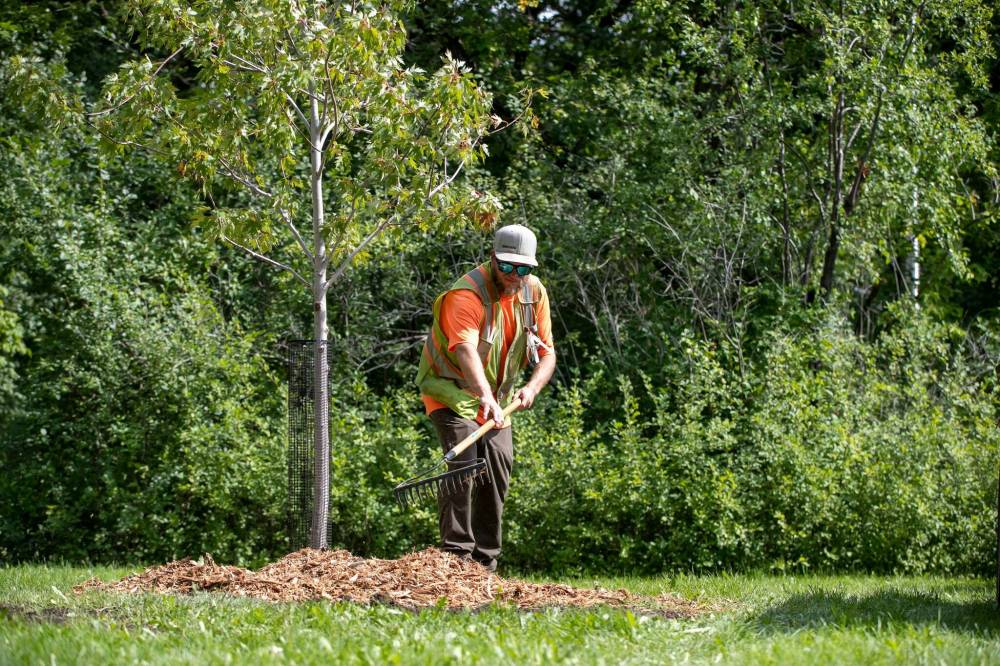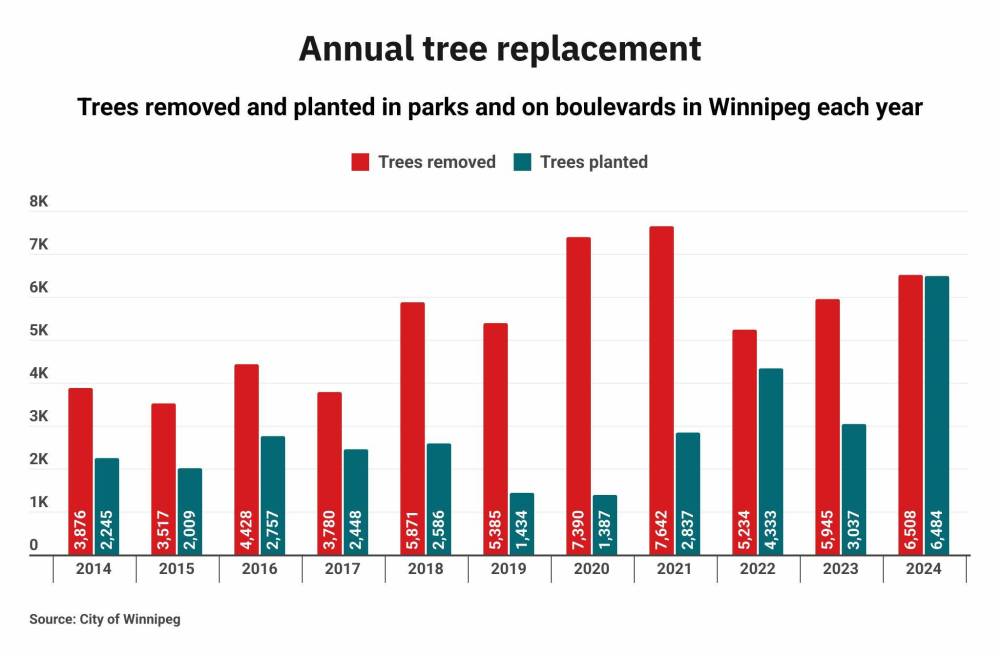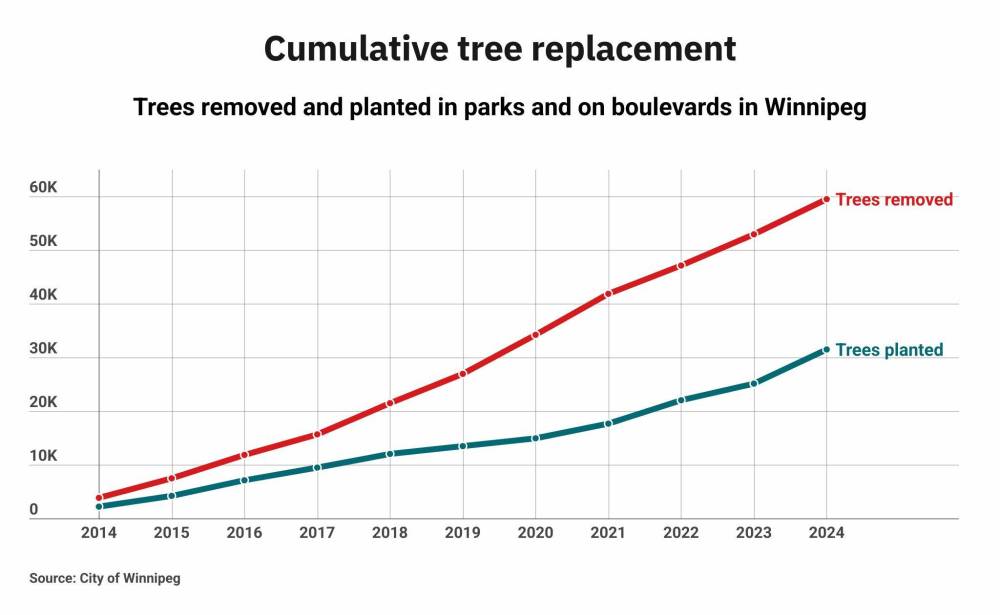City planted almost as many trees as it removed last year
Advertisement
Read this article for free:
or
Already have an account? Log in here »
To continue reading, please subscribe:
Monthly Digital Subscription
$0 for the first 4 weeks*
- Enjoy unlimited reading on winnipegfreepress.com
- Read the E-Edition, our digital replica newspaper
- Access News Break, our award-winning app
- Play interactive puzzles
*No charge for 4 weeks then price increases to the regular rate of $19.00 plus GST every four weeks. Offer available to new and qualified returning subscribers only. Cancel any time.
Monthly Digital Subscription
$4.75/week*
- Enjoy unlimited reading on winnipegfreepress.com
- Read the E-Edition, our digital replica newspaper
- Access News Break, our award-winning app
- Play interactive puzzles
*Billed as $19 plus GST every four weeks. Cancel any time.
To continue reading, please subscribe:
Add Free Press access to your Brandon Sun subscription for only an additional
$1 for the first 4 weeks*
*Your next subscription payment will increase by $1.00 and you will be charged $16.99 plus GST for four weeks. After four weeks, your payment will increase to $23.99 plus GST every four weeks.
Read unlimited articles for free today:
or
Already have an account? Log in here »
For the first time more than a decade, the City of Winnipeg planted almost as many public trees as it lost in 2024, falling just 24 short of its one-to-one replacement goal.
With 6,508 trees removed and 6,484 planted, the city’s forestry department managed to avert a long-term trend that saw Winnipeg lose hundreds or thousands more than it added each year, since at least 2014.
“In some years, we’ve had 5,000 trees… (in) deficit. So, to (nearly) reach, I’ll call it a milestone, of a one-to-one ratio is great news. I think it should be the floor, it should be the new normal,” said Christian Cassidy of Trees Winnipeg, a non-profit advocacy group.
BROOK JONES / FREE PRESS Urban Forestry Branch worker Stephan Nault places woodchips around a newly planted silver cloud seedling. Winnipeg’s forestry strategy aims to expand the local tree canopy to cover 24 per cent of the city, up from 17 per cent, by 2065.
For decades, Winnipeg’s canopy has thinned out, with the city planting far fewer trees on public land than it lost to natural death, severe weather, development and disease. Between 2014 and 2024, 59,576 public trees were lost and just 31,557 were planted, for an overall loss of 28,019, city data shows.
Cassidy said large, mature trees are a signature of Winnipeg and should be protected due to their esthetic value, ability to absorb excess water and store carbon.
He credits the city with making tree planting a higher priority in recent years.
“We’re just starting to see the results,” he said.
Since the majority of Winnipeg trees grow on private land and are not managed by the city, more must be done to boost the overall canopy, said Cassidy.
“If we’re talking about trying to fill some of that tree deficit, or add hundreds of thousands of trees over the next (few decades), it’s everybody’s responsibility…. The city (alone) is not going to tree-plant us out of this,” he said.
Winnipeg’s forestry strategy aims to expand the local tree canopy to cover 24 per cent of the city, up from 17 per cent, by 2065.
Cassidy said he hopes landowners, schools and other organizations will launch planting initiatives of their own. He said the city would also benefit from finally implementing a tree protection bylaw.
The city has pondered such a bylaw since at least 2022, which would potentially create fines for damaging or removing protected trees on private property and natural areas. In December 2023, city council approved an urban forest strategy that recommends the new bylaw.
However, a long-awaited report with options to actually add a bylaw isn’t expected until later this year, the city confirmed.
St. Vital Coun. Bran Mayes said he’s hopeful council will vote on a bylaw soon, noting the city’s goal to ramp up housing construction could mean many additional tree removals.
“If you were going to be taking down trees to put up new housing… we need more (protections),” said Mayes.
The councillor said he expects a bylaw would need to include fines for people who cut down protected trees.
“I would hope that it would have some teeth…. In the Glenwood area we’ve lost a ton of trees (in recent years),” he said.
The head of council’s community services committee said a bylaw proposal is taking time to complete, since multiple city policies would be affected.
Coun. Vivian Santos (Point Douglas) said any new rules must be considered with the impact on property rights in mind.
“When we start looking at private land, developers, homeowners… are we looking at (requiring that) every homeowner pulls a permit to cut down an apple tree, if they want to? Those conversations need to happen and I think proper consultation is really important.”
Meanwhile, a neighbourhood group is raising money in an effort to prevent more trees from being killed by Dutch elm disease. Wolseley Residents’ Association has launched a “Help Save Our Elms” project to raise money to inoculate elm trees against the disease.
Cassidy said it’s great to see concerned residents work to save trees but it would be very expensive for the city to complete similar inoculations throughout Winnipeg.
“You’re looking at (hundreds of dollars) per tree. The inoculation lasts for three years and then you have to do it again…. It’s a tough call for the city,” he said.
A city spokeswoman said inoculations are not part of the city’s program.
“We manage (Dutch elm disease) on a large scale, therefore our efforts are better directed towards timely sanitation and elm bark beetle control. These are the strongest components in reducing the spread of DED and preserving the canopy,” Julie Dooley wrote in an email.
joyanne.pursaga@freepress.mb.ca
X: @joyanne_pursaga

Joyanne is city hall reporter for the Winnipeg Free Press. A reporter since 2004, she began covering politics exclusively in 2012, writing on city hall and the Manitoba Legislature for the Winnipeg Sun before joining the Free Press in early 2020. Read more about Joyanne.
Every piece of reporting Joyanne produces is reviewed by an editing team before it is posted online or published in print — part of the Free Press‘s tradition, since 1872, of producing reliable independent journalism. Read more about Free Press’s history and mandate, and learn how our newsroom operates.
Our newsroom depends on a growing audience of readers to power our journalism. If you are not a paid reader, please consider becoming a subscriber.
Our newsroom depends on its audience of readers to power our journalism. Thank you for your support.




